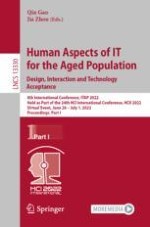This two-volume set constitutes the refereed proceedings of the 8th International Conference on Human Aspects of IT for the Aged Population, ITAP 2022, held as part of the 24th International Conference, HCI International 2022, held as a virtual event, during June-July 2022.
ITAP 2022 includes a total of 75 papers, which focus on topics related to designing for and with older users, technology acceptance and user experience of older users, use of social media and games by the aging population, as well as applications supporting health, wellbeing, communication, social participation and everyday activities. The papers are divided into the following topical sub-headings.
Part I: Aging, Design and Gamification; Mobile, Wearable and Multimodal Interaction for Aging; Aging, Social Media and Digital Literacy; and Technology Acceptance and Adoption: Barriers and Facilitators for Older Adults
Part II: Intelligent Environment for Daily Activities Support; Health and Wellbeing Technologies for the Elderly; and Aging, Communication and Social Interaction.
